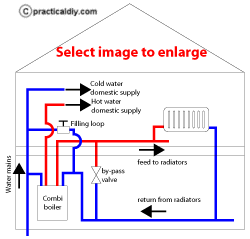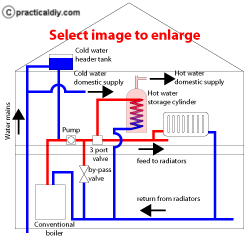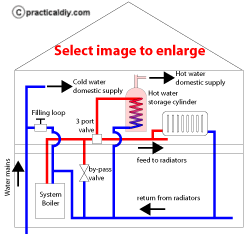High efficiency condensing boilers
Modern UK building regulations require that new and replacement gas boilers fitted into domestic properties are highly efficient condensing boilers – if your boiler is older than about 10 years, the probability is that it is not a condensing boiler and thus is fairly inefficient.
A condensing boiler
A condensing boiler uses modern technology to maximise the efficient use of the fuel (usually gas or oil) - typically a condensing boiler will be up to 90% efficient, whereas old boilers can be as low as 70%.
The design of the boiler extracts more heat from the burner by using a highly efficient heat-exchanger and by feeding the cooler water returned from the radiators through a secondary heat exchanger in the hot flue gases so that the water is warmed before entering the boiler.
Condensing boiler are known as such the temperature of the flue gases is lower and the moisture in it 'condenses', this water drains away through the bottom of the boiler –this 'drain' is normally through a pipe to the outside of the building, this pipe is one significant difference to an 'old' boiler installation.
Modern condensing boilers can be divided into three types which actually define the type of system used to supply the central heating and domestic hot water.
- Combination boiler (or Combi)
- Conventional boiler (or “traditional” boiler)
- System boiler
Each of these types uses the same high efficiency technology, but the one best suited for your property will depend on various factors, including the type of property,your lifestyle and what, if any, system is already installed.
Combination Boilers
 A combination boiler (or combi) provides the hot water for both the domestic hot water supply and the central heating as it is required – the system does not have a storage tank for the hot water.
A combination boiler (or combi) provides the hot water for both the domestic hot water supply and the central heating as it is required – the system does not have a storage tank for the hot water.
The water for the domestic hot water taps is fed directly from the cold water mains and it is heated by the combi can the water is drawn off at the taps.
The water for the central heating system is in a pressurised, closed loop system which is heated by the combi when required and pumped around through the radiators.
In properties where space is limited, combi boilers have the advantage of not requiring a header and hot water storage tanks – however a disadvantage is that there is no hot water storage tank for an airing cupboard.
The biggest advantage with a combination boiler is probably that it delivers continuous hot water at mains pressure – you are not limited to just a storage tank full of hot water. However,the domestic hot water flow from a combi is at, effectively, mains pressure and when two taps are open, the flow rate to each will be less than if only one tap were open. A high capacity combi will help provide better water flow when more than one tap is open.
In theory, a combi boiler should provide an effective shower being at mains pressure, however, taking cold water off of the mains elsewhere in a system will probably reduce the water flow through the combi and, with most combi's, this will have the effect of increasing the temperature of the water flowing out of the boiler –so the flow and temperature at the shower will vary. Using a thermostatic showerhead should, at least, maintain the temperature.
Combi's are usually considered to be one of the most straightforward systems to design and install, as there's no need for an expansion or storage tank. Limitations on installing a combi are usually 'model specific' and include the water pressure and flow rate, and the size of the gas supply pipe – these should be checked by the installer during the pre-installation survey . While the gas supply pipe can often be replaced to the metre if necessary, problems with the water pressure/flow are often found be insurmountable;just because a combi boiler was fitted in the past, does not mean that the gas or water supplies will satisfy a modern combi boiler.
Conventional boilers
 In a conventional boiler, the water is heated and stored for domestic use in a hot water tank (usually a cylinder) or fed around through radiators for space heating.
In a conventional boiler, the water is heated and stored for domestic use in a hot water tank (usually a cylinder) or fed around through radiators for space heating.
The boiler, hot water tank and radiators are fed from open header water tanks, the level of water in each being controlled by a float valve of some sort. Usually the water pressure at the hot water taps is 'fairly dismal',is does increase with increases in the vertical distance between the tap and header tank but is seldom adequate for a really good shower unless a shower pump is installed.
One drawback of the conventional hot water boiler system is that it takes time to re-heat the water in the tank once the hot water has been drawn off.
Installation is more complicated than with a combi boiler as a conventional boiler usually requires additionally two cold water header tanks (at an elevated position to the boiler) and a hot water tank. If space is not at a premium this does allow for an airing cupboard which can be useful.
System Boilers
 Like a conventional boiler, a system boiler stores the domestic hot water in a tank however, a system boiler has the major components for the hot water system built in to the boiler itself. Typically, the pump, which with a conventional boiler would normally be separate from the boiler, is built in to a system boiler; likewise so is the expansion vessel, which removes the need for the header tanks. The various valves and vents together with the system programmer are also built in.
Like a conventional boiler, a system boiler stores the domestic hot water in a tank however, a system boiler has the major components for the hot water system built in to the boiler itself. Typically, the pump, which with a conventional boiler would normally be separate from the boiler, is built in to a system boiler; likewise so is the expansion vessel, which removes the need for the header tanks. The various valves and vents together with the system programmer are also built in.
With these components built in to the boiler, installation is simplified, there's no need to find space for the header tanks etc., and less materials are needed.
